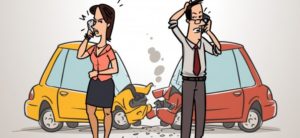Do I Pay The Excess On My Car Accident Claim If I Am Not At Fault?
What is Excess?
An excess is the amount of money that you pay towards a claim on your insurance. Two amounts make up your excess amount total. The types are required and voluntary excess. The insurer decides required excess and voluntary excess based on what you could afford to pay if you claimed. Usually, you only must pay the excess for your losses when you are at fault.
For a free legal consultation, call (725) 900-9000
Collecting Excess Damages in Nevada
It is not a very common outcome for an injured claimant to collect bonus payments. But there are certain situations in which you may collect excess.
These situations can include:
- Taking Advantage of a defendant’s umbrella claim. An umbrella policy is a personal liability insurance that kicks in when someone has exhausted their regular insurance coverage. The average driver might not have this. However, if you are in an accident with a semi-truck, delivery van, or other commercial driver there is a good chance the company will have an umbrella policy.
- Filing an underinsured motorist claim. Underinsured/ uninsured motorist (UIM/UM) coverage is a type of coverage that will cover losses in case of an accident in which the other driver is at fault, but their insurance is either absent or will not be enough to cover your losses.
- Suing the at-fault driver. If your damages exceed the at-fault driver’s policy limits, and you do not have UM/UIM insurance, your next option is to file a personal injury claim. In this instance, an experienced personal injury attorney can help you maximize your payout and advocate for you.
- Suing more than one defendant. Sometimes there is more than one driver at fault. In these cases, you can collect from all at-fault drivers’ insurance for your losses. In other cases, you may be able to sue vehicle and parts manufacturers if your injuries were the direct result of or worsened by a faulty auto party.
- Assigning your claim to a bad faith insurance lawsuit. “Bad faith” refers to insurance companies wrongfully refusing or avoiding paying a claim. In Nevada, if an at fault driver’s insurance company acts in bad faith only the policyholder will be able to sue.
How Is Fault Determined?
Nevada is a fault state. This means that the person determined to be at fault for the accident is responsible for damages or injuries. The insurance companies determine fault. Sometimes your insurance company may determine that you are partially at fault for the accident. There are factors that will make the biggest difference in your car accident claim such as the speed you and the other driver were going, weather conditions, traffic signals and rules, police reports, and whether a driver admits fault.
Keep in mind that the other party’s insurance will do everything that they can to not pay you a large settlement. Therefore, an attorney can be crucial to your case. It is extremely important that you prove your side of the story and an experienced attorney can advocate for your side of the story.
Click to contact our personal injury lawyers today
How Much Can I Receive For My Losses?
In Nevada, it is required for motor vehicle owners and operators to carry certain amounts of liability insurance. The 25/50/20 rule is followed in Nevada.
- $25,000 for bodily injury or death per person
- $50,000 for total bodily injury or death per accident
- $20,000 for property damage per accident
Keep in mind that UM/UIM insurance can help cover the amount that is left over under this rule. In Nevada, insurers must offer UM/UIM coverage to policyholders that is equal to any liability insurance policy purchased.
The best way to assure that your injury claim is handled competently and that you won’t be stuck paying for any damages in excess of your settlement is to call the award winning personal injury attorneys at Van Law Firm. Consultations are always free. Call us today!
No obligation consultations are always free.
Let Us Help You! Call Now: (725) 900-9000


